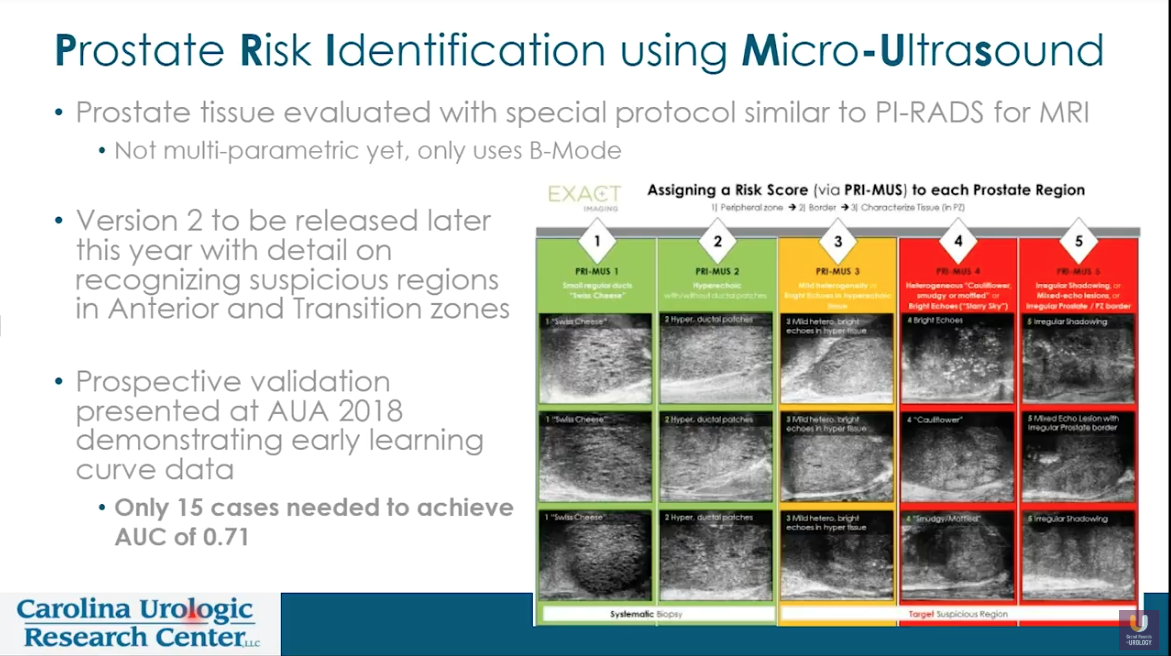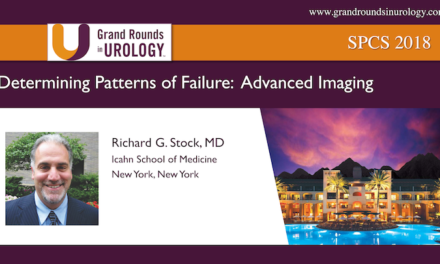Neal D. Shore, MD, presented “A Novel Micro-Ultrasound System for Improving Transrectal Prostate Biopsy” accompanied by E. David Crawford, MD.
How to cite: Shore, Neal D. “A Novel Micro-Ultrasound System for Improving Transrectal Prostate Biopsy” October 2, 2018. Accessed [date today]. https://grandroundsinurology.com/micro-ultrasound-system/
A Novel Micro-Ultrasound System for Improving Transrectal Prostate Biopsy – Summary:
Neal D. Shore, MD, introduces a real-time high resolution micro-ultrasound system for calculating prostate malignancy risk levels and guiding prostate biopsies. He also compares accuracy and practical benefits of micro-ultrasound to conventional ultrasound and MRI-guided biopsy techniques.
Real-Time High Resolution Micro-Ultrasound Compared to Conventional Ultrasound
Conventional transrectal ultrasound has been an essential aspect of prostate cancer diagnostic management for the past 30 to 40 years. Because of the limitations of conventional ultrasound, urologists have used templated or MRI-guided biopsy techniques. However, those technologies have significant cost, physician learning-curve, and logistical issues.
Micro-ultrasound is a novel technology that operates at 29 MHz, as opposed to the conventional speeds of 6-9 MHz. This technology has a relative 300% improvement in both axial and lateral resolution, providing detailed visualization of prostatic margins as well as the peripheral zone, textural changes in tissue, and up to 50 mm of depth.
Prostate Risk Identification using Micro-Ultrasound (PRI-MUS)
Similarly to Prostate Imaging Reporting and Data System (PI-RADS) scoring, which relies upon MRI, micro-ultrasound enables the use of PRI-MUS scoring. PRI-MUS scoring evaluates risk levels according to micro-ultrasound images. Classifications in this system range from PRI-MUS 1, indicating lesions consistent with BPH, to PRI-MUS 5, indicating more malignant lesions. The manufacturer of the commercially available micro-ultrasound system also offers web-based learning to train physicians in recognizing patterns and identifying PRI-MUS scores.
Practical Aspects of Micro-Ultrasound Biopsy
The practical application of micro-ultrasound is nearly identical to that of conventional, low-frequency ultrasound, with patients lying on their side in the knee-chest position, and the utilization of a similar periprostatic block. This system’s console can perform scrotal and abdominal ultrasound, as well as prostatic. Furthermore, a switch on the console allows a physician to adjust between low-frequency, conventional ultrasound and micro-ultrasound.
According to a report by Hyndman et al., a physician can generally achieve good PRI-MUS accuracy after performing 15 cases. Preliminary evidence suggests micro-ultrasound is similar to MRI in sensitivity and negative predictive value. Micro-ultrasound biopsy does not require a hospital visit or radiologic involvement. Therefore, this approach provides logistical convenience and cost savings for patients. Overall, this technique could reduce the need for multiparametric MRI when identifying targets for prostate biopsy.
ABOUT THE AUTHOR
Neal D. Shore, MD, FACS, graduated from Duke University and Duke University Medical School. He completed his general surgery/urology residency at New York Hospital-Cornell Medical Center/Memorial Sloan Kettering Cancer Center. He serves as the Medical Director for the Carolina Urologic Research Center and is the Chief Medical Officer, Strategic Growth and Pharmacy, GenesisCare, US.
Dr. Shore has conducted more than 400 clinical trials, focusing mainly on genitourinary oncology, and has authored or coauthored more than 350 peer-reviewed publications and numerous book chapters. He serves on the Society for Immunotherapy of Cancer (SITC) Guidelines Committee for Bladder Cancer, as well as the boards of the Bladder Cancer Advocacy Network, Maple Tree Alliance, and the Duke Global Health Institute. He is the Chair of both the Prostate Cancer Academy and the Bladder/Kidney Cancer Academy for the Large Urology Group Practice Association (LUGPA) Specialty Network. He also co-chairs the annual AUA International Prostate Forum. He has served/serves on the editorial boards of Reviews in Urology, Urology Times, Chemotherapy Advisor, OncLive, PLOS ONE, Urology Practice, JUOP and World Journal of Urology, and he also serves as an editor of Everyday Urology-Oncology. He is a Fellow of the American College of Surgeons.






